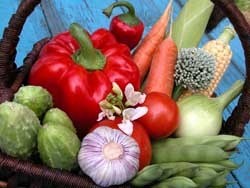You're growing your own vegetables and you can't wait to pick them. Well, you probably need to wait. But for how long? When will that tomato be ready? How about the cucumbers? How can you tell when carrots are ready to be harvested? How exactly do you pick leaf lettuce?
The fact is there are no specific rules that apply to all vegetables. In order to maximize flavor and texture, vegetables tend to be harvested just prior to turning ripe. So how can you tell that it's time to pluck, twist, cut or pick your bounty? Here are a few individual guidelines for some of the more popular homegrown vegetables, including carrots, cucumbers, lettuce, eggplant, onions, radishes and peas.
Carrots
Carrots, which can remain in the ground once ripe, are one of the most difficult vegetables to judge in terms of maturity. Check the tops of the carrots; they should be poking through the soil line. If that's the case, look at the diameter of the top of the carrot - does it look like it's the correct size? If it does chances are it's ready, but the only way you'll know for sure is by pulling one.
Cucumbers
Cucumbers should be picked when young, firm and smooth. These vegetables, which will turn bitter if left to become over ripe, need to be checked each day.
Eggplant
With eggplant make sure the fruit is glossy and firm but still not matured. When harvesting you want to cut and not pull the fruit.

Lettuce
To get the most from your leaf lettuce, harvest each plant in cycles. First pick the leaves on the outside edge of the plant when they are about 4 inches tall. Leave the immature, inner leaves to grow and pick once they've reached the proper height. This process should continue throughout the summer. With head lettuce, check with a gentle squeeze to see if it has a solid and full feel.
Radishes
Radishes are ready to harvest when they reach their mature size (check the seed packet). Pull them from the ground immediately or the roots will get woody and bitter and start to crack.
Onions
When onion or garlic tops ripen they fall over. That means it's time to pick them. To bring onions or garlic to full maturity you should dry them in the sun prior to storing. Dig them from the ground with a large fork or trowel rather than pulling them out.
Peas
Harvest snap beans and peas before they bulge out and fully ripen. Pea pods should appear and feel full but not plumped out, while snap beans should "snap" crisply in two after being picked. Because they can lose their resiliency quickly while on the vine, check both of these vegetables daily. Snow peas are ready when the pods reach 2 to 4 inches but still remain flat.
Tomatoes
Tomatoes, which should be twisted off the plant, are best when they feel soft but not squishy when you touch them. Pick when fully colored. After harvesting do not refrigerate but leave in the open air away from direct sunlight. Make sure all your tomatoes are in by the first hard frost. Leave the green ones in a box filled with newspaper under your bed and they'll ripen over the course of a few weeks.
When taking vegetables fresh off the vine remember that most taste best and last longer when taken a little early. Young, newly harvested vegetables tend to retain their taste, texture and color longer and will be a daily reminder of why you've labored in your garden throughout the planting, growing, and picking seasons.